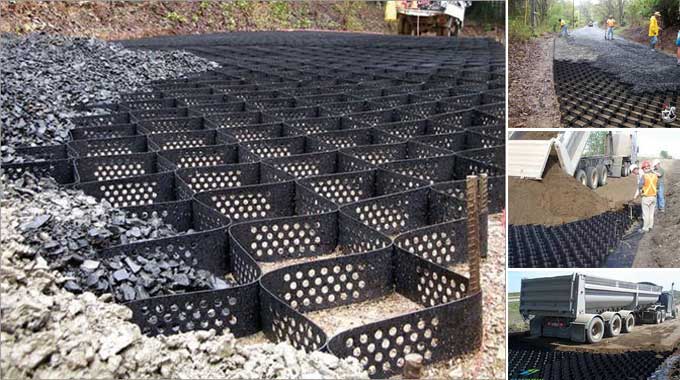
Geocell in Construction, types and its merits and demerits
Geocell in Construction was first invented in between the late 1970s and early 1980s. Geocell can be defined as a Cellular Confinement system that is three-dimensional, lightweight, and made of High-density polyethylene (HDPE).
It is by default a strong and ultrasonically welded, it is expandable on-site and has a honeycomb-like structure. During installation, the strips that are interconnected to each other expand and form flexible three-dimensional structural walls where materials are placed and compacted.
The depth of the Geocell in construction can vary according to the requirements. It forms a rigid to semi-rigid composite structure. Geocell is generally filled with sand or gravel materials. It also creates a free-drainage system that holds the materials and prevents movement. It also improves the structural functions of soil and average filling materials.
The field model sample structure was designed to compare Geocell with a normal CC road. Both experimental and comparative study was to be carried out on embankment support with Geocell and without Geocell.
The main intention of this experiment is to study the properties of embankment with Geocell and normal cement concrete road. It also clearly helps to study the various features, the load-carrying capacity of pavements with Geocell, and simple CC road.
Type of Geocell
Geocell can be differentiated basically into two types:
- Perforated Geocell: This type of Geocell has uniform holes in the walls that help in the proper distribution of pressure and reduce deformation. The large number of edges that later turn into cells is the main reason for improved pressure distribution. The strength and integrity mainly depend on perforated panels within.
- Non-Perforated Geocell: This type of Geocell have smooth, thick walls. It is also a three-dimensional structure with usually a polymer sheet with ultrasonic welding.
Merits of Geocell in Construction
- Geocell can be available with a variety of cell sizes, depths, length of sections, etc according to the requirements.
- Geocell gives strong protection to a layer.
- It provides great structural integrity and also provides significant sub-class deformations.
- It is comparatively easy to transport and install Geocell.
- It is high resistance in handling stress or pressure, tearing, punching, fatigue.
- It is an environment-friendly material.
- Geocell is highly durable, lightweight, and cost-effective.
- The use of Geocell is proved very economically sound compared to other similar products.
- The life span and reliability of a structure get boosted.
- They also help in the formation of soil sound-absorption structures.
Demerits of Geocell in Road construction
- The long-term performance of Geocell basically depends on the Formulated resin used in it, must make sure to use suitable materials like antioxidants, ultraviolet filters, etc.
- Management, storage, and installation are to be thoroughly regulated to get expected quality results.
To get more details, watch the following video tutorial.
Video Source: Presto GeoSystems
Conclusion
The main purpose of Geocell in Construction is mainly used to control and prevent soil erosion and stabilize the soil, structural reinforcement to sustain load support. Geocell is a proven way to create a strong, efficient, reliable, and cost-efficient way of construction. Geocell is generally widely used in many environmental projects.


